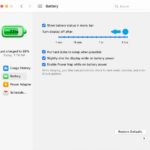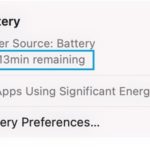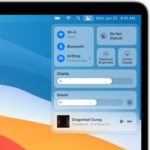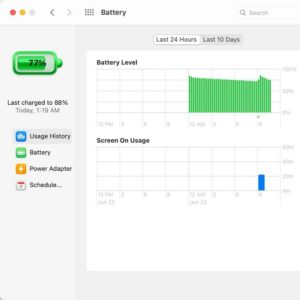macOS Big Sur Battery Usage History & Time Remaining Estimates
The Battery Usage History is divided in two sections: Batter Level and Screen On Usage. The second graph shows how much time you spent on your Apple computer. Unlike iOS, macOS Big Sur doesn’t seem to add detailed info about the apps that are the biggest battery consumers. However, we’re still in the early beta testing stages and a detailed battery usage history could be added until the public release scheduled for this fall.
How To Check Battery Usage History In macOS Big Sur
1. On your Mac, click the battery icon available in the status bar, next to the time & date.
2. Select ‘Battery Preferences…’
3. The Usage History tab is displayed as home screen.
Fact: The stats for the last 24 hours are provided by default. Tap on ‘Last 10 days’ to check the Mac’s battery levels in the past.
4 Ways To Save Battery on Mac
In the same Battery Preferences window, described above, tap on Battery (left sidebar).
 1. First, make sure that your Mac’s display automatically turns off after a short wait. Anything between 1 to 5 minutes is OK. Don’t go for longer if you want to extend uptime.
1. First, make sure that your Mac’s display automatically turns off after a short wait. Anything between 1 to 5 minutes is OK. Don’t go for longer if you want to extend uptime.
2. Enable the ‘Put hard disks to sleep when possible’. Macs save energy when the hard disks take a break. Let’s assume that you’re composing a text, you’re not using lots of resources and some functions can go idle.
3. Check the ‘Slightly dim the display while on battery power’ option. The Mac’s display is one of the biggest energy consumers.
4. You can also enable your Mac to get a ‘Power Nap’ while running on battery power. The Power Nap feature is only available for Macs with a flash memory. This way Macs can periodically update even when they’re sleeping.
macOS Big Sur Power Adapter Section
The Battery Preferences also include the ‘Power Adapter’ section. Here you can tweak how your Mac reduces power consumption when connected to a power source. Differently from Battery power, you can allow it to:
– Prevent Mac from sleeping when the display is off,
– Wake for Wi-Fi network access.
Fact: There is also a 4th tab called ‘Schedule’ in the macOS Big Sur Battery Preferences app. It allows you to schedule when your Apple computer should automatically wake up or go to sleep. Scheduled ‘start ups’ will only trigger if the Mac is connected to a power adapter.
macOS Big Sur Battery Time Remaining Estimation
 Last but not least, macOS 11 brings back the battery time remaining estimation. Apple pulled this info back in macOS Sierra (2016) because of lack of accuracy.
Last but not least, macOS 11 brings back the battery time remaining estimation. Apple pulled this info back in macOS Sierra (2016) because of lack of accuracy.
To find out how much battery uptime there’s still left without connection your Mac to a power outlet, you have to click the battery icon, available in the menu bar.
The same icon that you use for opening the new ‘Battery Preferences…’ screen.
No Battery Percentage Indicator in macOS Big Sur
 The first Developer beta doesn’t include a battery percentage indicator for the macOS Big Sur menu bar!
The first Developer beta doesn’t include a battery percentage indicator for the macOS Big Sur menu bar!
We’re not sure yet if this is a bug or if Apple has decided to pull back this feature.
The battery percentage indicator was also pulled from the iPhone, because it could not fit in the notch design. However, you can now display it on your Home screen with the help of the Battery widget, or by swiping for the the Control Center.
In macOS Big Sur the battery percentage is displayed when you click the battery icon in the menu bar. Let’s hope this is just a bug. It wouldn’t make sense for Apple to kill the battery percentage indicator because, there’s enough space in the menu bar!
What’s the average autonomy that you get from your Mac? Use the comments section available below. For accurate comparisons please mention what Mac version you own, what macOS it runs and how old the computer is.
Related: Check out which Macs are compatible with macOS Big Sur!

